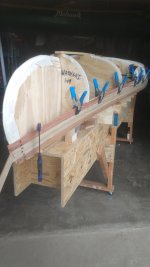I guess I am just about ready to actually start working on my Wee Lassie 2. I don't expect to get going in earnest right away, but I purchased the templates, Mac's book, canoe bits for cove and bead, and I a couple Diablo blades are on the way. I figure I'll start prefabbing stuff in advance. Forms, strong back, strips...
What did you use for forms? Particle board, MDF, plywood? 1/2"? Any of those I should avoid like the plague? Or lust buy what I can get cheaply? I figure I may use the same stuff for the strong back. They used to have 1/2" luan for pretty cheap at the big box stores but I haven't seen it in years.
Not sure if I will build a second Wee Lassie 2, but I might. If not I may want to pass on the forms to someone so they might as well be built well enough to build a few boats.
What did you use for forms? Particle board, MDF, plywood? 1/2"? Any of those I should avoid like the plague? Or lust buy what I can get cheaply? I figure I may use the same stuff for the strong back. They used to have 1/2" luan for pretty cheap at the big box stores but I haven't seen it in years.
Not sure if I will build a second Wee Lassie 2, but I might. If not I may want to pass on the forms to someone so they might as well be built well enough to build a few boats.

